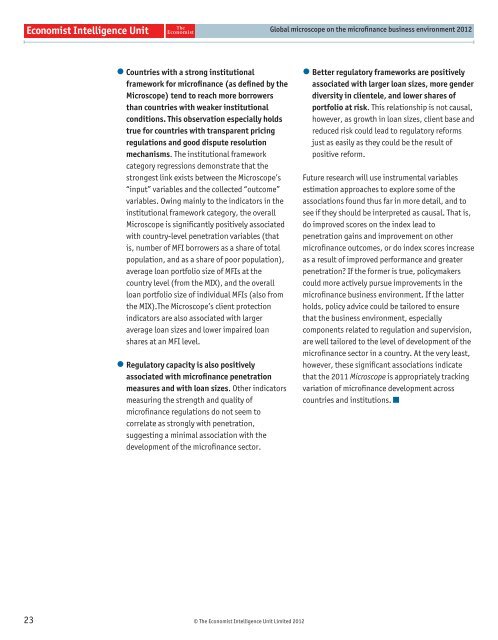Global microscope on the microfinance business environment 2012
Global microscope on the microfinance business environment 2012
Global microscope on the microfinance business environment 2012
You also want an ePaper? Increase the reach of your titles
YUMPU automatically turns print PDFs into web optimized ePapers that Google loves.
23<br />
l Countries with a str<strong>on</strong>g instituti<strong>on</strong>al<br />
framework for microfi nance (as defi ned by <strong>the</strong><br />
Microscope) tend to reach more borrowers<br />
than countries with weaker instituti<strong>on</strong>al<br />
c<strong>on</strong>diti<strong>on</strong>s. This observati<strong>on</strong> especially holds<br />
true for countries with transparent pricing<br />
regulati<strong>on</strong>s and good dispute resoluti<strong>on</strong><br />
mechanisms. The instituti<strong>on</strong>al framework<br />
category regressi<strong>on</strong>s dem<strong>on</strong>strate that <strong>the</strong><br />
str<strong>on</strong>gest link exists between <strong>the</strong> Microscope’s<br />
“input” variables and <strong>the</strong> collected “outcome”<br />
variables. Owing mainly to <strong>the</strong> indicators in <strong>the</strong><br />
instituti<strong>on</strong>al framework category, <strong>the</strong> overall<br />
Microscope is signifi cantly positively associated<br />
with country-level penetrati<strong>on</strong> variables (that<br />
is, number of MFI borrowers as a share of total<br />
populati<strong>on</strong>, and as a share of poor populati<strong>on</strong>),<br />
average loan portfolio size of MFIs at <strong>the</strong><br />
country level (from <strong>the</strong> MIX), and <strong>the</strong> overall<br />
loan portfolio size of individual MFIs (also from<br />
<strong>the</strong> MIX).The Microscope’s client protecti<strong>on</strong><br />
indicators are also associated with larger<br />
average loan sizes and lower impaired loan<br />
shares at an MFI level.<br />
l Regulatory capacity is also positively<br />
associated with microfi nance penetrati<strong>on</strong><br />
measures and with loan sizes. O<strong>the</strong>r indicators<br />
measuring <strong>the</strong> strength and quality of<br />
microfi nance regulati<strong>on</strong>s do not seem to<br />
correlate as str<strong>on</strong>gly with penetrati<strong>on</strong>,<br />
suggesting a minimal associati<strong>on</strong> with <strong>the</strong><br />
development of <strong>the</strong> microfi nance sector.<br />
© The Ec<strong>on</strong>omist Intelligence Unit Limited <strong>2012</strong><br />
<str<strong>on</strong>g>Global</str<strong>on</strong>g> <str<strong>on</strong>g>microscope</str<strong>on</strong>g> <strong>on</strong> <strong>the</strong> microfi nance <strong>business</strong> envir<strong>on</strong>ment <strong>2012</strong><br />
l Better regulatory frameworks are positively<br />
associated with larger loan sizes, more gender<br />
diversity in clientele, and lower shares of<br />
portfolio at risk. This relati<strong>on</strong>ship is not causal,<br />
however, as growth in loan sizes, client base and<br />
reduced risk could lead to regulatory reforms<br />
just as easily as <strong>the</strong>y could be <strong>the</strong> result of<br />
positive reform.<br />
Future research will use instrumental variables<br />
estimati<strong>on</strong> approaches to explore some of <strong>the</strong><br />
associati<strong>on</strong>s found thus far in more detail, and to<br />
see if <strong>the</strong>y should be interpreted as causal. That is,<br />
do improved scores <strong>on</strong> <strong>the</strong> index lead to<br />
penetrati<strong>on</strong> gains and improvement <strong>on</strong> o<strong>the</strong>r<br />
microfi nance outcomes, or do index scores increase<br />
as a result of improved performance and greater<br />
penetrati<strong>on</strong>? If <strong>the</strong> former is true, policymakers<br />
could more actively pursue improvements in <strong>the</strong><br />
microfi nance <strong>business</strong> envir<strong>on</strong>ment. If <strong>the</strong> latter<br />
holds, policy advice could be tailored to ensure<br />
that <strong>the</strong> <strong>business</strong> envir<strong>on</strong>ment, especially<br />
comp<strong>on</strong>ents related to regulati<strong>on</strong> and supervisi<strong>on</strong>,<br />
are well tailored to <strong>the</strong> level of development of <strong>the</strong><br />
microfi nance sector in a country. At <strong>the</strong> very least,<br />
however, <strong>the</strong>se signifi cant associati<strong>on</strong>s indicate<br />
that <strong>the</strong> 2011 Microscope is appropriately tracking<br />
variati<strong>on</strong> of microfi nance development across<br />
countries and instituti<strong>on</strong>s.















![Joint Report on Social Protection and Social Inclusion [2005]](https://img.yumpu.com/19580638/1/190x132/joint-report-on-social-protection-and-social-inclusion-2005.jpg?quality=85)
